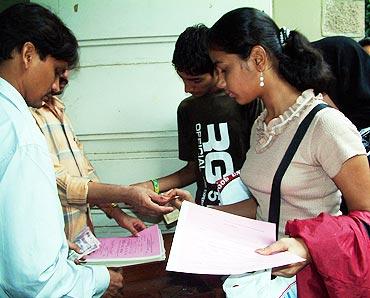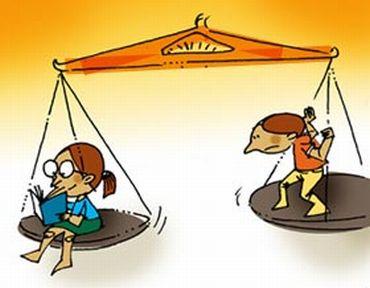
Perhaps no other discipline evokes as much glamour and celebrity-steeped power as the field of design. However, if you want admission to one of the many design campuses burgeoning across the country, you will have to epitomise research, application and dedication.
Identifying your design calibre
Before you attempt to crack any of the design entrances, it is important to identify your vital skills and nurture them. A design student must evolve into an artist, technocrat, thinker, businessman and a visionary.
"Aspirants should have good visual and spatial aesthetics, interest in reading and creative writing, research, people skills, observational skills, awareness about lifestyle trends, and interest in different national and international communities," advises Vaibhavi Ranavade, Associate Professor and HOD - Fashion Design, Symbiosis Institute of Design.
Most selection committees look for these qualities. But some institutions go a step further. "NID is unique as it focuses on problem-solving capabilities and intellect, and has a creative, educational culture that promotes design competencies and sets standards in design education. The rigorous development of the designer's skills and knowledge through a process of 'hands on minds on' is what makes the difference," says Vibha Mitra, Chief Mentor, Opus, a Kolkata-based coaching institute.
Typically, there is no prescribed formula to crack design entrance tests, and often there is no right or wrong answer. Dipen Desai, an alumnus of NID, expands further, "NID is very subjective. So it is very difficult to know what they are looking for. They want to know your creativity, adaptability, and eagerness to learn from what someone has to offer. Ultimately, the suitability and marketability of a design matters." And this maxim holds good for almost all well-equipped design institutes.
The author is a fashion communication consultant and visiting faculty at leading design institutions in the country.

Almost all design institutes have a range of three to four-year (or more) undergraduate (UG) bachelor's programmes, and two-year (or more) postgraduate (PG) master's programmes. A few of them also have advanced courses.
The UG pre-requisite is 10+2 or equivalent, and the PG pre-requisite is a bachelor's degree or graduation (sometimes in a required subject). The duration and cost of each course varies from institute to institute.
Must-do: Check if the course offers a bachelor's or postgraduate degree, or a diploma certificate.
NID offers a Post Graduate Diploma Programme in Design (PGDPD) and a Graduate Diploma Programme in Design (GDPD). NIFT offers Bachelor's in Design (B Des) and Master's in Design (MDes).
Srishti School of Design has a Foundation Studies Programme, Professional Diploma Programmes and Advanced Diploma programmes. Other colleges have similar courses.

Creative skills
Vibha: "Design is about having an eye for detail, breaking rules and setting trends. Being a keen observer in your daily life can help you conceptualise ideas. You need to have a natural flair for illustrating. Having an artistic flair with colour, materials, textures or fabrics is beneficial."
Vaibhavi: "Hobbies like sketching; photography; travelling; public speaking; dramatics; and appreciation of performing arts; films; and music -- all prove helpful."
Technical skills
Vibha: "Mastery over new and old tools is a must to produce and implement your solutions. In other words, a strong combination of basic tactile and virtual knowledge works wonders."
Vaibhavi: "Working knowledge of any digital software like illustrator, Photoshop, and more, could come in handy. Foreign languages like French or Italian could be learnt."
People skills
Vibha: "In the design industry, establishing relationships, maintaining mutual respect, having a positive outlook and ultimately motivating others to seek you out is important to succeed." Let's say that communication makes the creative world go round and build on it.
Business skills
Vibha: "In order to advise clients, you need to clearly understand their business challenges, trends and options. Understanding the nuances of retail, trade and business will help."

Broadly, specialisation is offered in the following design fields -- fashion, leather, accessory, textile, knitwear, fashion communication, apparel production, graphic and communication.
Alternatively, you can also opt for one of the lateral design courses -- product, craft, space, transportation, animation, exhibition (spatial), ceramic and glass, furniture and interior, user experience or interface, film and video, retail, make-up, sustainability, craft management, entrepreneurship, and the like, offered by some institutes. Do your research and mention the desired field at the time of application. Be aware that the seats are limited, so focus well.

You can either appear for the National Entrance Examination for Design (NEED) conducted by NID, the Common Entrance Test (CET) conducted by SNDT Women's University under Government of Maharashtra, or for other respective examinations conducted by other institutions. NID as well as several other design institutes take the NEED score into consideration for admission.
The CET score is accepted by SNDT as well as many other institutes. Note that SNDT and NID do not handle the admission procedures directly in the associate/consortium institutions, which are done separately by the respective institutions.
Many undergraduate and postgraduate institutions have courses courses have separate entrance examinations. You will have to appear for a national or internal examination (if it is a solitary institute without branches). For instance, NIFT conducts its own written test (February 2011). Other institutes also have similar examinations with slight differences in exam name or style.
Selection for advanced courses is based on a graduate or postgraduate degree, work experience (in the desired design sector), personal interview and portfolio (a collation and compilation of personal and professional artwork that has to be presented precisely and creatively). This should ideally reflect your passion for the subject.
Normally, there are two tests in the first stage of NIFT.
1. General Ability Test (GAT) for all courses
2. Creative Ability Test (CAT) for design courses OR Managerial Ability Test (MAT) for apparel production, management and technology courses
There are two other tests in the second stage as well.
3. Situational Test for design courses
4. Personal Interview (PI) followed by a Group Discussion (GD) phase (only for PG courses or Master's.)
At NIFT, the final score is calculated based on a ratio of marks and varies across Bachelor's and Master's programmes. Typically, it is 40 per cent GAT, 40 percent CAT, 20 per cent Situational Test (Bachelor's programme in design); 60 percent GAT, 40 percent MAT (Bachelor's programme in apparel production); 40 per cent GAT, 40 per cent MAT, 10 percent GD and 10 per cent Interview (Master's programmes in design, management and fashion technology). The score decides the merit list and the city/centre you are allotted. However, this ratio is subject to change at NIFT and may vary at other institutions. It is suggested that you thoroughly read the prospectus of various institutions before you apply.
The NID entrance test has two or three phases after the form-filling stage.
1. Design Aptitude Test for Post-Graduate Diploma Programme -- GDPD or the National Entrance Exam for Design for Graduate Diploma Programme in Design (GDPD).
2. Studio Test followed by Personal Interview for undergraduate and postgraduate courses.
3. Portfolio Review and Personal Interview (for some PG and advanced courses).
Like GAT and CAT, NEED and CET test your design aptitude, mental ability, creativity, sketching, communication skills and world view. This written examination is followed by a Studio Test and Personal Interview. The number of seats is usually limited. So if you miss these examinations or do not crack them, you can appear separately at the institutions as per their datelines.
Some institutes like the NID and Srishti School of Design go beyond the student's previous academic qualifications and vigorously hunt for that wee bit of extra "creativity, dynamic thinking and perception." They also seek "trans-disciplinary" design element and lateral collation through student portfolio.

National Entrance Exam for Design (NEED)
Forms available at: Nationalised banks, designated Bank of India branches, via a demand draft request to NID (Ahmedabad), or downloaded off the NID website (and the completed application form to be sent along with a Demand Draft to NID).
For more details: sndtcet.in
General Ability Test (GAT)
This written test (usually of two hours) is an objective test that examines the candidate's basic intelligence and aptitude for logical thinking. It is conducted for all Bachelor's and Master's programmes. Institutions like NIFT have negative marking for every wrong answer. You will have to be clear about the rules before you appear.
Typically, the test components include the following.

Managerial Ability Test (MAT)
If you are appearing for an apparel production (Bachelor's course), or technology/management (Master's courses) at NIFT, you will be put through an objective Managerial Ability Test (MAT) that checks your "management effectiveness and interpersonal skills." Other colleges may have managerial ability questions in their written examinations. But the preparation can be the same for all. The NIFT exam has three segments.

Dos and don'ts for CAT
Dos and don'ts for Situation Test
Dos and don'ts for Design Aptitude Test (DAT)